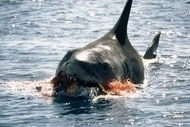Create a free profile to get unlimited access to exclusive videos, sweepstakes, and more!
Training Jaws: How sharks learn whether hunting is worth their time
Who would have thought a shark could learn when it's being lied to?

The year was 1975 and the beach town of Amity Island was plagued by a ravenous man-eating shark in the waters just offshore. Fearing the impact it will have on the town’s summer-tourism-based economy, the local mayor turns a blind eye and pretends it isn’t happening. But when a young boy is claimed by the shark, the mayor does what any good politician in the ‘70s would do, he hires a bounty hunter to end the shark’s reign of terror once and for all.
More deaths and one explosion later, Amity Island is rid of the Great White scourge. Finally, it’s safe to go back in the water. At least until it’s time for a Jaws sequel. The events of that summer made for a thrilling action adventure film so successful it birthed the modern summer blockbuster. It’s possible, however, that it all could have been avoided with a better understanding of what motivates sharks.
Dennis Heinrich from the College of Science and Engineering at Australia’s Flinders University, and colleagues, studied how sharks learn to associate environmental cues with hunting success in order to decide whether or not particular stimuli is worth pursuing. Their findings were published in the journal Animal Behavior.
“We wanted to know how shark-feeding tourism would affect the behavior of sharks. Some shark tourist operators use only smell to attract sharks and we were curious how quickly sharks would start to ignore a strong food-related stimulus like smell. We know almost nothing about this simple form of learning in sharks,” Heinrich told SYFY WIRE.
Scientists used Port Jackson sharks, which are common to the waters around Sydney, Australia, and constructed an experiment which would allow them to expose sharks to a food-related smells under varying conditions. The idea was to present a smell to the sharks and then reward or withhold a meal to see how the sharks reacted over time. To do that, they needed a way to provide a food smell to the sharks without always having the associated food present.
Scientists defrosted frozen squid in a bucket of salt water and used that water to make ice cubes. Squid flavored ice might not sound very appetizing to you, but they make good experimental bait for Port Jackson sharks.
“We put the ice cubes in a box and dropped them into the arena. That way we had a consistent inflow of smell that lasted about four minutes,” Heinrich said.
The sharks were broken up into three groups. The first group was rewarded with a meal every time they moved toward the smell source. The second group was rewarded half of the time, every other day. The last group was never rewarded. Sharks are often thought of as mindless killing machines, incapable of learning, simply moving automatically through the environment and responding to stimuli. These experiments showed that isn’t the case. Sharks are able to learn, and quickly.
“The group that was never rewarded showed really clear signs of habituation to the smell of squid and the group that was rewarded every single time associated that smell with the reward very quickly,” Heinrich said.
In fact, the sharks who were rewarded every time got faster and faster at approaching the source of the smell, indicating that learning was being reinforced. That faster response time increased throughout the experiment and never plateaued, at least not before the trial was over.
The ability of Port Jackson sharks to take in environmental stimuli over time and modify their behavior accordingly has some potential implications for species management, especially in places where sharks and humans interact.
That said, Heinrich was appropriately cautious about what conclusions we’re able to draw from this particular study.
“You have to start somewhere. We need to get a feel for different species and how they respond to a similar setup to get an average overall response for different types of sharks. It’s difficult to extrapolate results of one species to another species, simply because they rely on sensory systems differently,” Heinrich said.
Some species of shark, like the Port Jackson, are good for experiments because they are relatively hardy and easy to maintain in captivity. Larger sharks, like Great Whites, are significantly more challenging owing not only to their size but also because they need to constantly move through large environments in order to survive.
Still, if we can learn more about what makes sharks tick, what they respond to and what they ignore, we can develop plans to better manage the ways we interact and keep potentially dangerous animals away from beachgoers without needing to explode oxygen tanks inside their mouths.



























